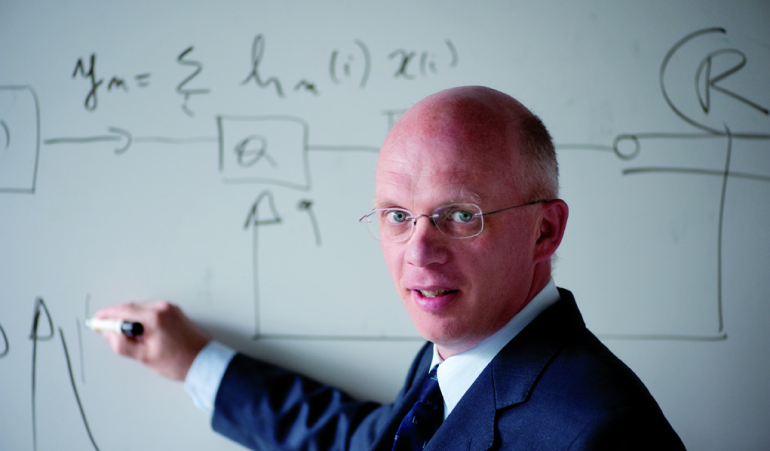
For Expo 2025 in Osaka, Wallonia has focused on the concept of digital twins to develop its scenography. But what are digital twins? Professor Benoît Macq explains this concept of the medicine of the future.
The theme of Expo 2025 in Osaka, which runs from April 13 to October 13, 2025, is “Designing the future society for our lives”, a reflection on global challenges and solutions for a better future. Belgium, via its national pavilion, is developing the “Human Regeneration” theme. To illustrate this subject, the designers were inspired by the Japanese concept of Kintsugi, a Japanese method of repairing broken porcelain or ceramics using lacquer sprinkled with gold powder, giving it a unique beauty that speaks of its history. This poetic approach, inspired by the Japanese concept of Kintsugi, embodies the capacity for rebirth and reconstruction, and highlights Belgian excellence in life sciences and health.
In this context, Wallonia is devoting its scenographic space to artificial intelligence in the service of health, with a particular focus on digital twins. But what is a digital twin? "The idea is that we're all a bit the same, and we're all different. The first difference is that we all have a particular genome. Our genomes are very similar because, from the embryonic stage, DNA is programmed to give us a brain, eyes, nose, mouth and so on. It's a program that makes us who we are, and it's common to every human being. But at the same time, there's something special about us. Some are bald, others have hair. Some have blue eyes, others brown. Each individual is the same but completely different at the same time. How do we capture this difference? Through the person's genome, but also through a number of other characteristics, such as the way their body is exposed to the outside world. Every human being is unique, and we're going to be able to carry out specific medical treatment on them, so we'll be able to predict what might happen to them. If she's at risk of breast cancer, we'll do regular mammograms at a younger age to detect the cancer as early as possible and treat it in the best possible way. This is what we call predictive medicine. It's the first P," explains Benoît Macq, a professor at the Université Catholique de Louvain specializing in image processing. His laboratory has been involved in the creation of a dozen spin-off companies.
"The second P is personalization. If someone is ill and we have a digital copy of that human, we can make a treatment that is different from another person. For some people, we'll use radiotherapy; for others, we'll combine radiotherapy and immunotherapy. For others, it will be chemo and surgery. I'm talking about cancer, but I could also be talking about neurodegenerative diseases, mental health, alcohol addiction and so on. These are all diseases that can be treated in a very personalized way if we understand the person's profile. If we understand who we are and if we have a digital copy of ourselves, we can practise preventive and participatory medicine, i.e. I manage my illness and I even avoid illness because I know that I have weak points and so I don't expose my body to these weaknesses," continues Benoît Macq.
“The aim of the digital twin is to represent an individual in a unique and personalized way, by capturing data on that individual in order to practice that famous 4P medicine: prediction (screening), personalized treatment, patient participation and avoiding being patient with prevention”, adds our interlocutor.
It was on this principle of digital twins that the scenography was developed. "When you enter the scene, you see all the humans who are the same, they're all indistinguishable. And then data arrives. This data arrives on each of the humans and that's what makes them different. And then each human becomes his or her own digital copy somewhere," explains Benoît Macq.
At present, the digital twin of a complete body does not yet exist. But several companies in Wallonia have already worked, with the help of artificial intelligence, on the digital twin of a human body part, organ or disease. "In the Walloon region, there's a lot of activity around pharma, with the development of medicines. But we're increasingly working on digital twin models for drug development, to determine which people will respond to the drug and which will not. This means we can test lots of molecules with fewer small animals, and save time", explains the UCLouvain professor.
Three conferences in Osaka
During the Wallonia-Brussels week, three half-days will be devoted to highlighting the Walloon region's scientific and technological know-how in the field of digital health and artificial intelligence applied to healthcare. The aim is to foster international collaborations and illustrate the potential of emerging technologies.
"The first strand concerns new ways of screening and clinical testing for drugs. The second is about ageing well through technologies and monitoring the elderly. The third is the human-centered robotized society, with everything from artificial intelligence to digital twins," explains Benoît Macq, who will be taking part in the three half-day sessions. “It won't just be presentations, but also moments of co-creation to work on potential partnerships,” concludes Benoît Macq.
A fine program for Walloon and Japanese companies, universities and research centers.
Isabelle Anneet (AWEX)